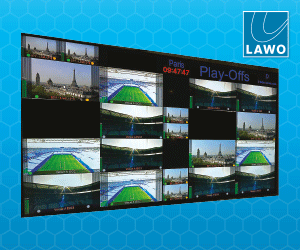Vincent Paul Tep explains why DVB-T transmissions are the way forward for national broadcasters looking to migrate from analogue to digital broadcasting Terrestrial broadcasting continues to be the most effective means of communication in a large number of international regions. National broadcasters in Europe, the Middle East, Africa and elsewhere still rely on over-the-air television […]
Vincent Paul Tep explains why DVB-T transmissions are the way forward for national broadcasters looking to migrate from analogue to digital broadcasting
Terrestrial broadcasting continues to be the most effective means of communication in a large number of international regions. National broadcasters in Europe, the Middle East, Africa and elsewhere still rely on over-the-air television and radio as the best way to communicate to their populations.
For some populations, radio and/or print are the only means of receiving communication from national broadcasters. Television, however, provides more credibility to the population as they can view the message as it is conveyed, rather than relying solely on audio or the printed word.
As these national broadcasters gradually migrate from analogue to digital broadcasting, its important to have a well-planned infrastructure to support a quick rollout. This infrastructure exists in the form of a digital video head-end to handle the various video processing and networking leading up to the transmission stage.
DVB-T is considered the most widely deployed digital terrestrial system on a global basis. More than 119 countries have thus far adopted or deployed the DVB-T standard, using mainly UHF or VHF spectrum. Analogue broadcasters adopting this standard today have the option of converting to DVB-T or directly to DVB-T2, which offers an increased spectrum use efficiency of 30-to-50% compared to DVB-T.
DVB-T/T2 delivers three key advantages over competing broadcast content delivery services. The first is that a simple, passive stick antenna is enough to receive programming. The TV set does not require links to an outside cable, satellite or IPTV service. Second, those receiving their broadcasts over the air will receive more services at better quality than what was possible with analogue transmission. Digital TV delivers more channels with associated digital applications, from electronic programme guides to Push VOD to a variety of rich media applications that present information or offer interactive applications when coupled with an internet connection by the consumer.
Third, broadcasting retains its local flavour by delivering certain content to a distinct region. Unlike satellite, where all contents are broadcast to the entire viewing audience, DVB-T/T2 channels can be inserted locally for delivery to a specific region. While both standards offer far more than analogue, DVB-T2 evolves the DVB-T standard through newer OFDM modulation, error correction and coding techniques that provide a far more robust signal.
Ultimately, these improvements result in the efficient use of terrestrial spectrum, allowing government and commercial broadcasters to deliver a wealth of digital services to fixed and mobile devices.
COMPLEX DISTRIBUTION
A DVB-T/T2 rollout cannot be seen as a video head-end (VHE) rollout only. It should instead be viewed as a complete rollout across the chain through to the transmitter (See Figure 1).
The challenge is not only to allocate frequencies, but also to build an entirely new infrastructure with cutting-edge technology. The complete structure includes:
A scalable and future-proof National VHE to build the national multiplex. The National VHE is the DVB-T/T2 national infrastructure where the transport stream is built
A robust satellite, IP, cable or microwave uplink to cover the entire territory via national delivery
An optional local VHE to re-mux and insert regional services
Reception equipment, such as integrated receiver-decoders, at each antenna to receive the national multiplex and transmit it to the modulator
Antenna and transmitter sites at selected locations for delivery to the consumer
Single-frequency networks add complexity, requiring multiple DVB-T/T2 transmitters to modulate in phase to avoid interferences in overlap area.
Specific techniques in the form of DVB-T/T2 adaptation solutions are required.
DVB-T/T2 adaptation is essential to the performance of the entire chain.
These solutions are underestimated and often become the weakest point in the chain, as interoperability with the selected transmitter is not always guaranteed.
Most sources are delivered in SDI at premium quality, with the national broadcaster providing SDI sources direct from the studio. This makes the National VHE an encoding platform for premium DVB-T/T2 services.
New infrastructure and networking equipment exists in todays market to help national broadcasters build National and Local VHEs in an efficient manner. Like cable and satellite, five distinct blocks, or workflow functions, define the terrestrial National VHE:
Router Block: Video sources come from studios or from contribution via satellite, but are decoded and delivered to the VHE in SDI format. The router block directs the sources to the correct encoder. Routing is also necessary for encoder redundancy.
Encoders Block: This supports H.264 or MPEG-2 source encoding, depending on the choice of the DVB-T/T2 deployment, and is mostly accomplished within statistical multiplexing for bandwidth optimisation.
MUX Block: The MUX builds the final transport stream for viewers. This process combines all incoming signals from the encoder block in the form of statistical multiplexing, while also inserting DVB signalisation.
DVB-T/T2 Adaptation Block: This warrants adaptation if it is an SFN deployment, via insertion of synchronization data using GPS technology. DVB-T2 will further require adaption of the multiplexer output in T2 framing (PLP and encapsulation to the T2 frame).
Modulation Block: This depends on the way the final stream is carried over the air. Satellite is used for the most part, but the transport stream may also be carried via IP, cable or microwave. Strategic and financial considerations factor into this decision.
National VHE & DVB-T/T2 Adaptation
A DVB-T/T2 VHE uses the same process as any other VHE, but needs a specific complex adaptation strategy to support processes like SFN adaptation and T2 frame encapsulation. DVB-T/T2 adaptation is the key component that links the National VHE to the entire DVB-T/T2 transmitter infrastructure. It wont work without proper implementation, and broadcasters need to look at the VHE as a complete picture to understand its significance in the chain.
There are two ways to implement the DVB-T/T2 VHE. One is the discrete approach, the long-favoured method that employs a specialised method where each box serves a single function. This is a reliable method due to the redundant nature of the hardware installation (a monitored network with backup encoders), but there are a number of weaknesses (single point of failure in the network management system, high number of connectivity points).
The better strategy is the platform approach, which vastly simplifies the implementation. Rather than thinking box, the platform approach envisions the VHE workflow as a single, unified function including DVB-T/T2 adaptation. Reduced power consumption, fewer connectivity points and optimised redundancy are the chief benefits.
Recent industry trends point to the validity of the platform approach. The consolidation, or vertical integration, of more encoders into a single box was an initial step. The subsequent integration of more functionality into the same units, including SFN adaptation, video scrambling, multiplexing and sometimes modulation, proved the benefits of what we call horizontal integration.
The overall concept of the platform approach is to integrate the entire block at once, creating a VHE in a Box scenario without losing the benefits of a discrete design while simultaneously resolving its weaknesses. Additional takeaways from this approach include a granularity of one (compared to having four encoders in 1RU fail simultaneously, i.e., a granularity of four, cards can operate in clusters and backup cards can operate independent of chassis location). Other takeaways include built-in connectivity with no single point of failure, and preservation of the VHE network aspect for high reliability. Cable and rack-space requirements are vastly reduced; in fact, cables are required strictly for sources and output connections from the transport stream. This amounts to an approximate 93% reduction in cable. The comprehensive benefit to the industry is that the platform approach focuses on the application instead of the box, making DVB-T/T2 accessible to any broadcaster interested in these standards. Services can be added without hassle, maintenance is simplified and cost-per-local VHE is reduced.
Taking the entire concept into consideration versus the traditional discrete approach, the newer platform approach provides a complete and simple solution for DVB-T/T2 rollouts allowing national broadcasters to roll out digital TV services in the short term without requiring an immense investment in resources.
Vincent Paul Tep is product marketing manager, Contribution and Distribution, Harris Broadcast Communications.












































































